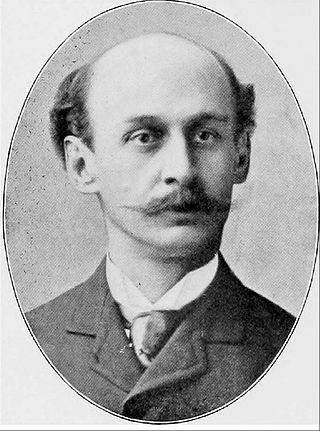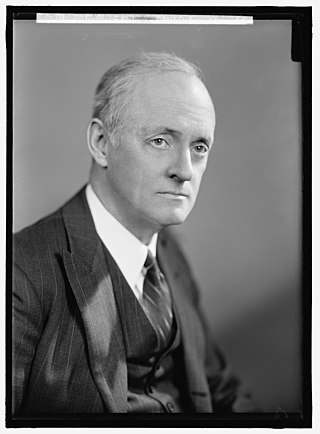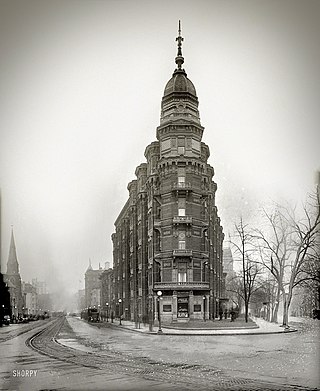
The National Trust for Historic Preservation is a privately funded, nonprofit organization based in Washington, D.C., that works in the field of historic preservation in the United States. The member-supported organization was founded in 1949 by congressional charter to support the preservation of America’s diverse historic buildings, neighborhoods, and heritage through its programs, resources, and advocacy.

Fifth Avenue is a major and prominent thoroughfare in the borough of Manhattan in New York City, New York, United States. It stretches north from Washington Square Park in Greenwich Village to West 143rd Street in Harlem. It is one of the most expensive shopping streets in the world.

The Watergate complex is a group of six buildings in the Foggy Bottom neighborhood of Washington, D.C. Covering a total of 10 acres just north of the John F. Kennedy Center for the Performing Arts, the buildings include:

Embassy Row is the informal name for a section of Northwest Washington, D.C., with a high concentration of embassies, diplomatic missions, and diplomatic residences. It spans Massachusetts Avenue N.W. between 18th and 35th street, bounded by Scott Circle to the south and the United States Naval Observatory to the north; the term is often applied to nearby streets and neighborhoods that also host diplomatic buildings, such as Kalorama.

Henry Janeway Hardenbergh FAIA was an American architect, best known for his hotels and apartment buildings, and as a "master of a new building form — the skyscraper." He worked three times with Edward Clark, the wealthy owner of the Singer Sewing Machine Company and real estate developer: The Singer company's first tower in New York City, The Dakota Apartments, and its precursor, the Van Corlear. He is best known for building apartment dwellings and luxury hotels.

Kalorama is a neighborhood in Northwest Washington, D.C., United States. It includes the Kalorama Triangle Historic District and Sheridan-Kalorama Historic District. It is named after the Kalorama mansion.

Alban Towers is an apartment building on Massachusetts Avenue in Northwest Washington, D.C. It is listed in the National Register of Historic Places, and is considered to be one of the best examples of Gothic Revival architecture in Washington.

Massachusetts Avenue is a major diagonal transverse road in Washington, D.C., and the Massachusetts Avenue Historic District is a historic district that includes part of it.

555 Edgecombe Avenue is an apartment building at the southwest corner of Edgecombe Avenue and 160th Street in the Washington Heights neighborhood of Manhattan in New York City. It was originally known as the Roger Morris Apartments when it was built in 1914–16 – after the retired British Army officer who built the nearby Morris–Jumel Mansion – and was designed by Schwartz & Gross, who specialized in apartment buildings. The building was declared a National Historic Landmark under the name Paul Robeson Residence in 1976, and it became a New York City designated landmark in 1993.
The Henley Park Hotel is a 96-room boutique style hotel located on 10th street and Massachusetts Avenue NW in Washington, DC. It features an upscale restaurant, The Tavern, and is noted for its unique architecture. The Henley Park Hotel is a member of Historic Hotels of America, the official program of the National Trust for Historic Preservation.

The Sixteenth Street Historic District is a 1.25-mile (2.01 km) linear historic district in Washington, D.C., that includes all structures along 16th Street NW between H Street and Florida Avenue. The district's southern boundary is bordered by Lafayette Square, just north of the White House, and Meridian Hill Park on its northern boundary. It includes an eclectic mix of architectural styles on one of the city's most historic and important numbered streets including single and multi-family residential buildings, embassies, hotels, churches, and office buildings.

David Edward Finley Jr. was an American cultural leader during the middle third of the 20th century. He was the first director of the National Gallery of Art, the founding chairman of the National Trust for Historic Preservation, chairman of the U.S. Commission of Fine Arts, a prime mover in the founding of the National Portrait Gallery, and founding chairman of the White House Historical Association. During the Second World War, Finley led the Roberts Commission, which led the rescue of much of the threatened artworks of Europe.

This is a list of the National Register of Historic Places listings in Detroit, Michigan.

Starrett & van Vleck was an American architectural firm based in New York City which specialized in the design of department stores, primarily in the early 20th century. It was active from 1908 until at least the late 1950s.

The Wilbraham is an apartment building at 282–284 Fifth Avenue and 1 West 30th Street in the Midtown South neighborhood of Manhattan in New York City. The nine-story structure was designed by David and John Jardine in the Romanesque Revival style, with elements of the Renaissance Revival style, and occupies the northwestern corner of 30th Street and Fifth Avenue. It was built between 1888 and 1890 as a bachelor apartment hotel. The Wilbraham is a New York City designated landmark and is listed on the National Register of Historic Places.

The Pan American Union Building is the headquarters for the Organization of American States. It is located at 17th Street N.W. between C Street N.W. and Constitution Avenue, Northwest, Washington, D.C.

Mount Vernon Triangle is a neighborhood and community improvement district in the northwest quadrant of Washington, D.C. The neighborhood is located adjacent to Mount Vernon Square. Originally a working-class neighborhood established in the 19th century, present-day Mount Vernon Triangle experienced a decline in the mid-20th century as it transitioned from residential to commercial and industrial use.

Appleton Prentiss Clark Jr. was an American architect from Washington, D.C. During his 60-year career, Clark was responsible for designing hundreds of buildings in the Washington area, including homes, hotels, churches, apartments and commercial properties. He is considered one of the city's most prominent and influential architects from the late 19th and early 20th centuries. Many of his designs are now listed on the National Register of Historic Places (NRHP).

The Portland Flats was the first luxury apartment building constructed in Washington, D.C. Construction of the elaborate building, designed by architect Adolf Cluss, was completed in 1881. It was built on the south side of Thomas Circle, a traffic circle and park where 14th Street NW, M Street NW, Massachusetts Avenue NW, and Vermont Avenue NW intersect. The triangular-shaped building's main architectural feature was the corner tower and dome, which resulted in the Portland Flats resembling an ocean liner sailing into Thomas Circle.


















